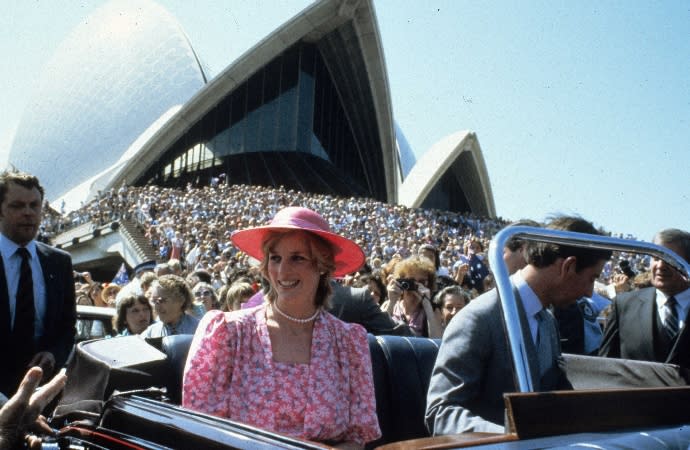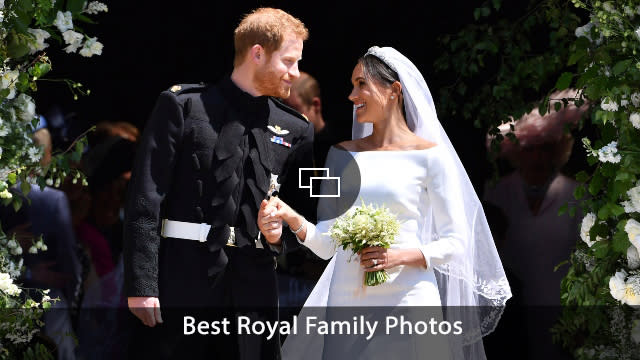Before Meghan & Diana, There Was Marie Antoinette: A Deep Dive on Sofia Coppola's Biopic 15 Years Later

- Oops!Something went wrong.Please try again later.
- Oops!Something went wrong.Please try again later.
- Oops!Something went wrong.Please try again later.
- Oops!Something went wrong.Please try again later.
There’s a moment in Sofia Coppola’s Marie Antoinette when the titular historic figure is seen wearing nothing but an opulent diamond necklace and dark lip paint, her hair donned in the highest updo, as she relaxes in the bath. The image is preceded by the sound of the poor French subjects screaming about the impoverishment they’ve endured at the hands of the monarchy. “Do you know what she said?” one voice is heard yelling above the rest. “Let them eat cake.” So goes the infamous, unceremonious reply of young queen Marie Antoinette, married to the future King of France when she was only 15 years old. But those words were never uttered by Marie Antoinette — as Coppola goes on to show, that was just one more piece of untrue gossip wielded against the immature monarch.
15 years ago today, Coppola’s Marie Antoinette debuted in U.S. theaters, an adaptation of Antonia Fraser’s biography Marie Antoinette: The Journey, and a notably more sympathetic perspective on the young Austrian dauphine than most. Coppola and Fraser both described Marie Antoinette as a teenage outsider, a constant topic of court gossip and distrusted by those in her new home country. Coppola’s 2006 film doesn’t just shine a light on the way Marie was maligned: it suggests that, long before Princess Diana and Meghan Markle became global media fixations, Marie Antoinette was the blueprint for how they’d be treated.
More from SheKnows
“Don’t they ever get tired of these ridiculous stories?” Kirsten Dunst as Marie Antoinette says upon hearing from her lady-in-waiting about the “let them eat cake” report. More exaggerations about Marie’s alleged escapades follow, including how she gave Thomas Jefferson a “special tour of her garden” — a report laden with innuendo. Upon being asked whether or not she’ll respond to these salacious stories, Marie tells her ladies, “I’m not going to acknowledge it,” choosing instead to continue her retreats to the country, or indulge in sweets, the opera, and fashion.

©Sony Pictures/courtesy Everett Collection
Click here to read the full article.
Centuries later, another amiable, naive teenager would be thrust into the limelight at the height of the tabloid media machine. But in many ways, Princess Diana served as the foil — the exact antithesis — of who Marie Antoinette supposedly was. Diana was, and largely remains, the Queen of People’s Hearts; extraordinarily philanthropic, approachable yet fashionable. Somehow everyone felt like they knew and still know Diana without ever having accessed her beyond photos, interviews, or a handshake.
Despite their completely different reputations, Marie and Diana had one thing in common. From the time Diana became engaged to Prince Charles she was constantly hounded by the media — photographed and followed in a constant siege on her life, with the chase for the perfect photo even contributing to her death. Similarly, young dauphine Marie was a target of speculation and gossip from the moment she arrived to the country she’d one day rule.
At 15, Marie married future monarch King Louis XVI, and at 18 she became the Queen of France. In Coppola’s film, Marie is shown as a teenager pressured to consummate her marriage and produce an heir. “Everything depends on the wife, if she is willing and sweet,” Marie’s mother writes to her daughter. Marie is facing pressure and suspicion from all sides: her own family, the French elite, and the public. Coppola’s sympathetic reading paints a young woman who — because of her nationality, inexperience, and immaturity — was practically doomed to fail.

Anwar Hussein/SIPA
In 2020, Meghan Markle and Prince Harry announced their decision to step back from the royal family and their roles as senior royals. Like Marie and Diana before her, Meghan was badgered by media criticism and gossip during her time in the royal spotlight. Perhaps even more so than Diana, Meghan’s story has salient parallels to the Marie Antoinette we see in Coppola’s film.
While Diana’s public favor has only grown since her death, the opposite has happened with Marie Antoinette. Marie’s taste for decadence became legendary in the centuries following her execution, and coincidentally grew as the shadow over France’s true issues that led to the monarchy’s downfall, many of which stemmed from her husband Louis XVI himself. As Meghan steps back from the royals, it’s still unknown how the public will characterize her public image.
Meghan Markle, like Marie Antoinette, came into the House of Windsor as an outsider: American, older, a woman of color, and previously married. Like Marie Antoinette in the centuries before her, Meghan became a scapegoat for anything that went wrong with the royal family during her time within it, and gossip and vitriol about the duchess were a relentless source of front-page tabloid news, no matter how much the royal hid herself away.

ASSOCIATED PRESS.
As with Marie, Meghan Markle was not an outsider the British tabloids were interested in embracing. The constant coverage, prying, and nonconstructive criticism of Meghan got to a breaking point, leading the duchess to suicidal ideation and the ultimate decision that she and Prince Harry should step back from their roles as senior royals. Meghan has already taken pains to set the record straight herself on the lies spread about her in the media, most notably with her Oprah Winfrey interview that gave a corrected account of her time in the royal family. Hundreds of years ago, given the opportunity, Marie Antoinette might have done the same.
Marie Antoinette, Princess Diana, and Meghan Markle were all smeared by tabloid taunting and media speculation and shared a beginning as outsiders to the royals by whom the public and media were fascinated. Coppola’s film showed the human side of Marie Antoinette that the legend surrounding her has often pushed us to ignore, and drew attention to just how unbearable the scrutiny on Marie was centuries before Diana and Meghan would share those stories too. Meghan’s story has many more chapters ahead, and it remains to be seen whether she’ll either be vilified or remembered beloved: treated like Marie or treated like Diana. As history’s shown us, there’s hardly any middle ground when you’re a royal woman.
Before you go, click here to see the 100 best photos of the royal family from the past 20 years.
Launch Gallery: Iconic Photos of Princess Diana That Will Always Live On
Best of SheKnows
A Look Back at Lucille Ball & Desi Arnaz's Complicated Life & Relationship in Photos
Angelina Jolie's Daughter Zahara & More Grown-Up Celebrity Kids Wearing Their Famous Mom's Dresses
Sign up for SheKnows' Newsletter.
For the latest news, follow us on Facebook, Twitter, and Instagram.


